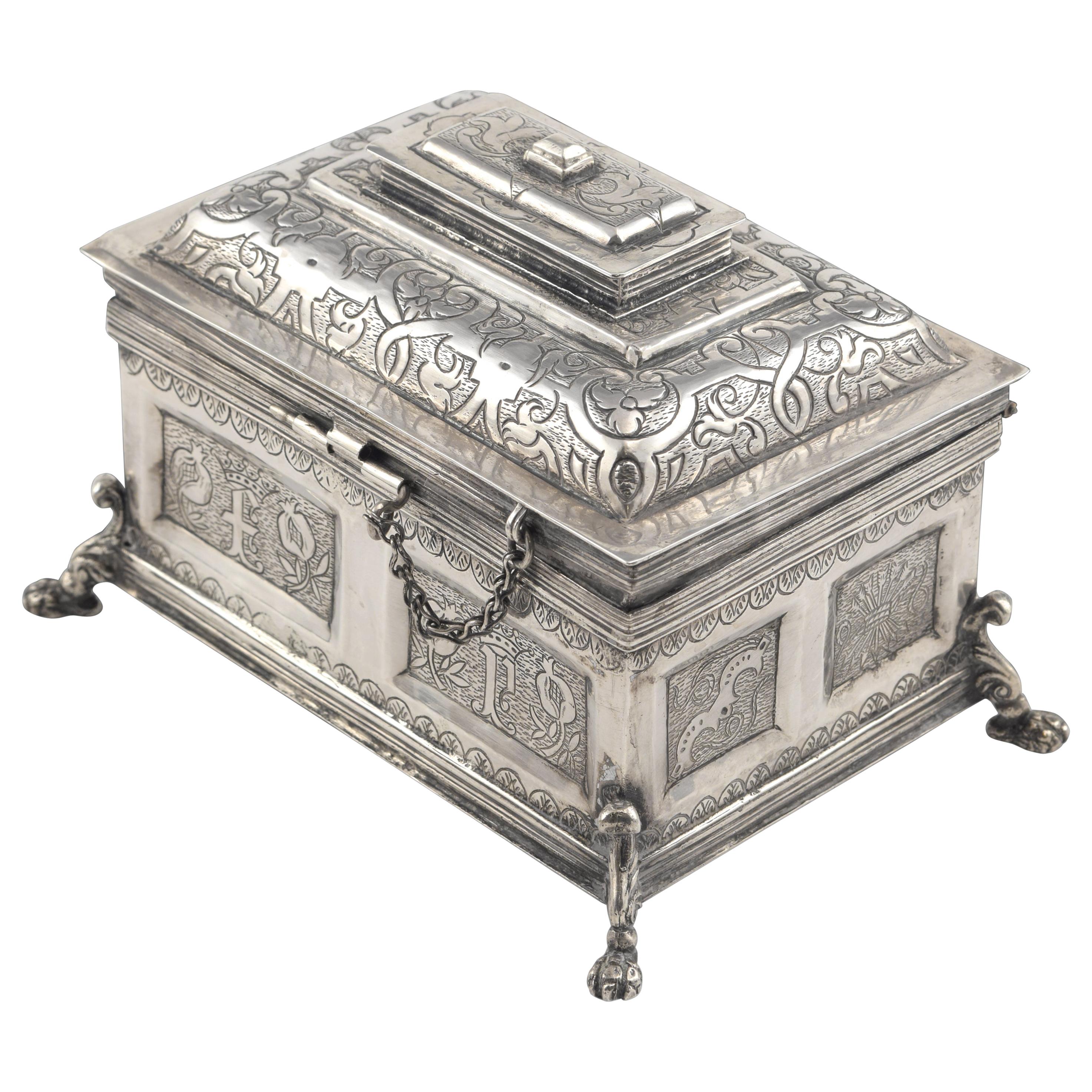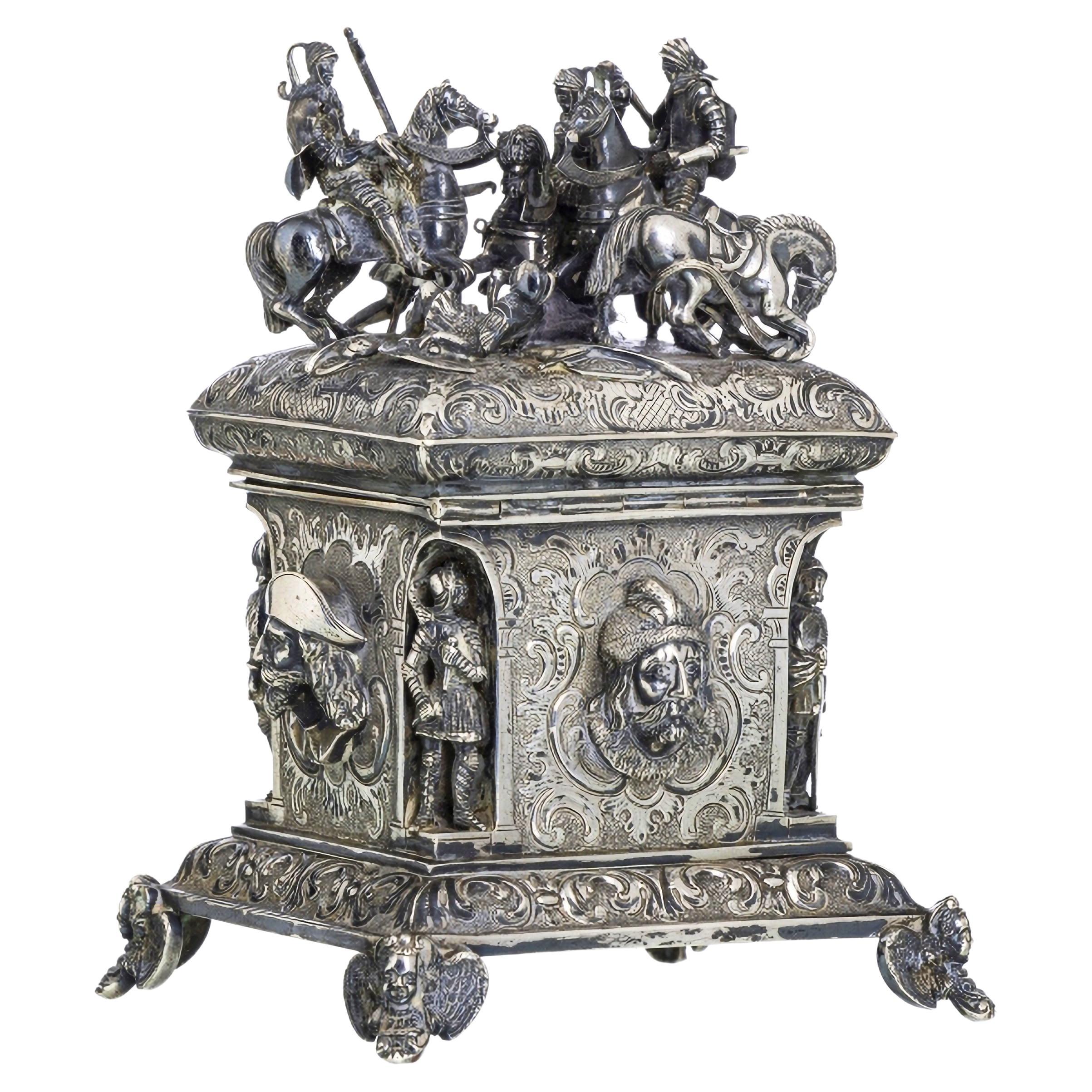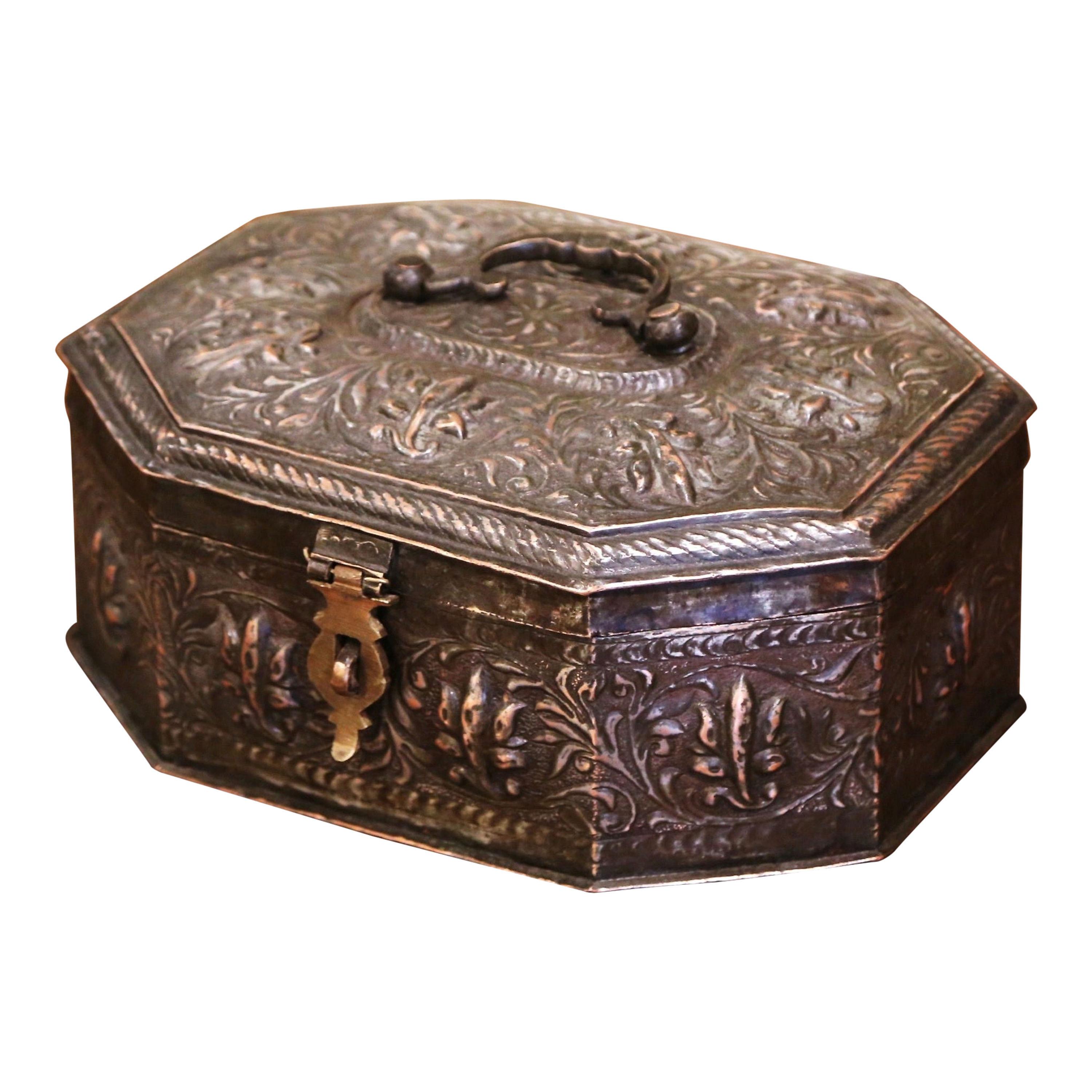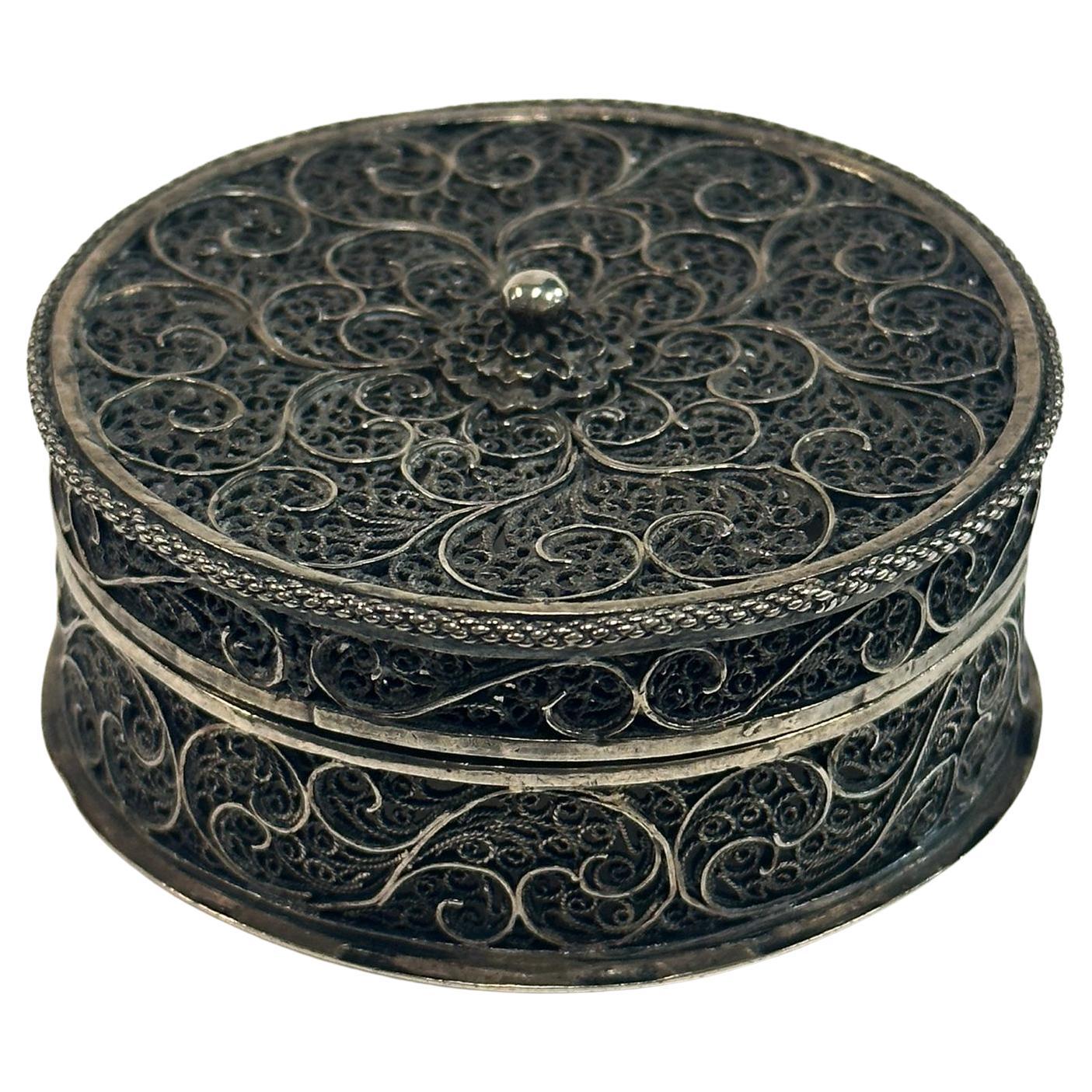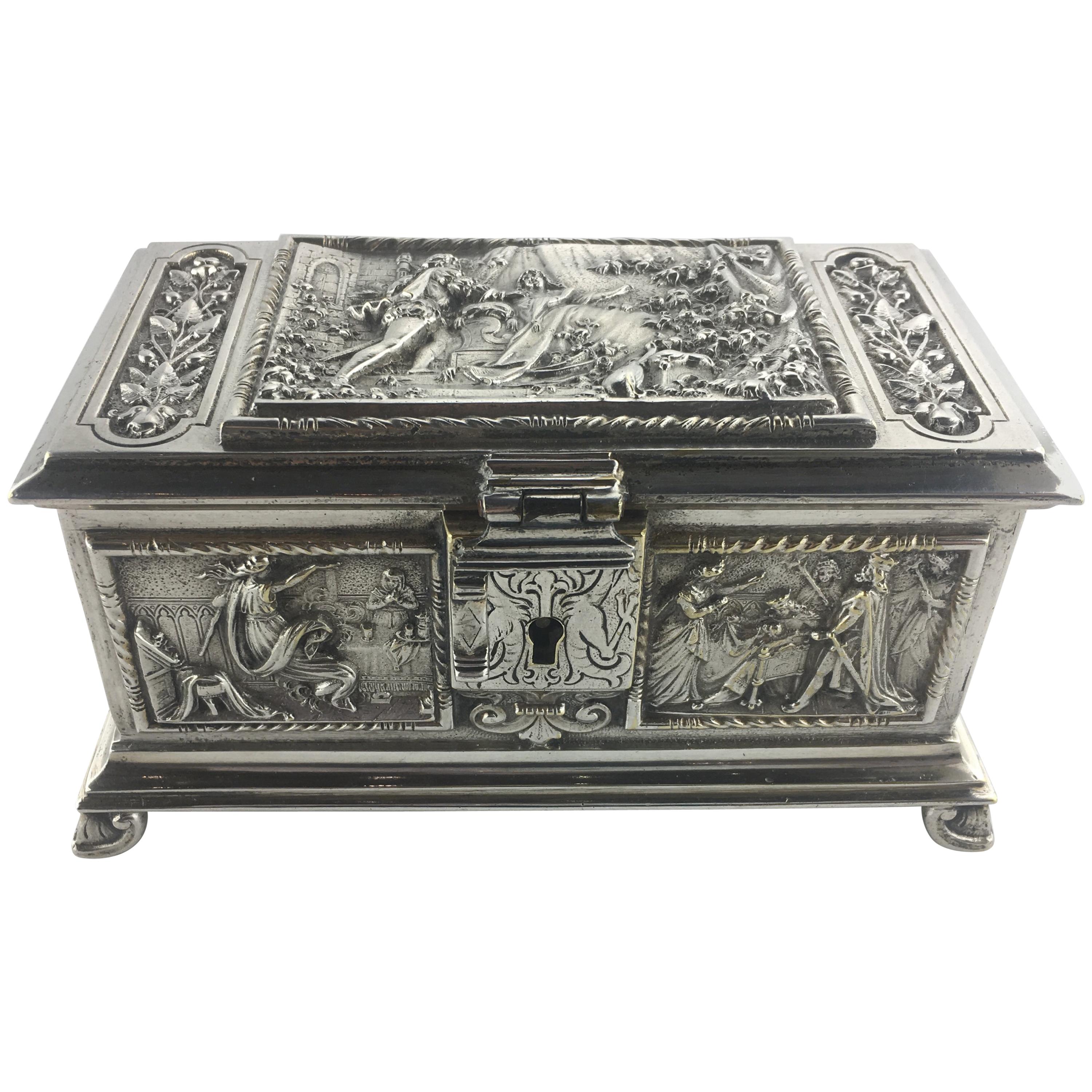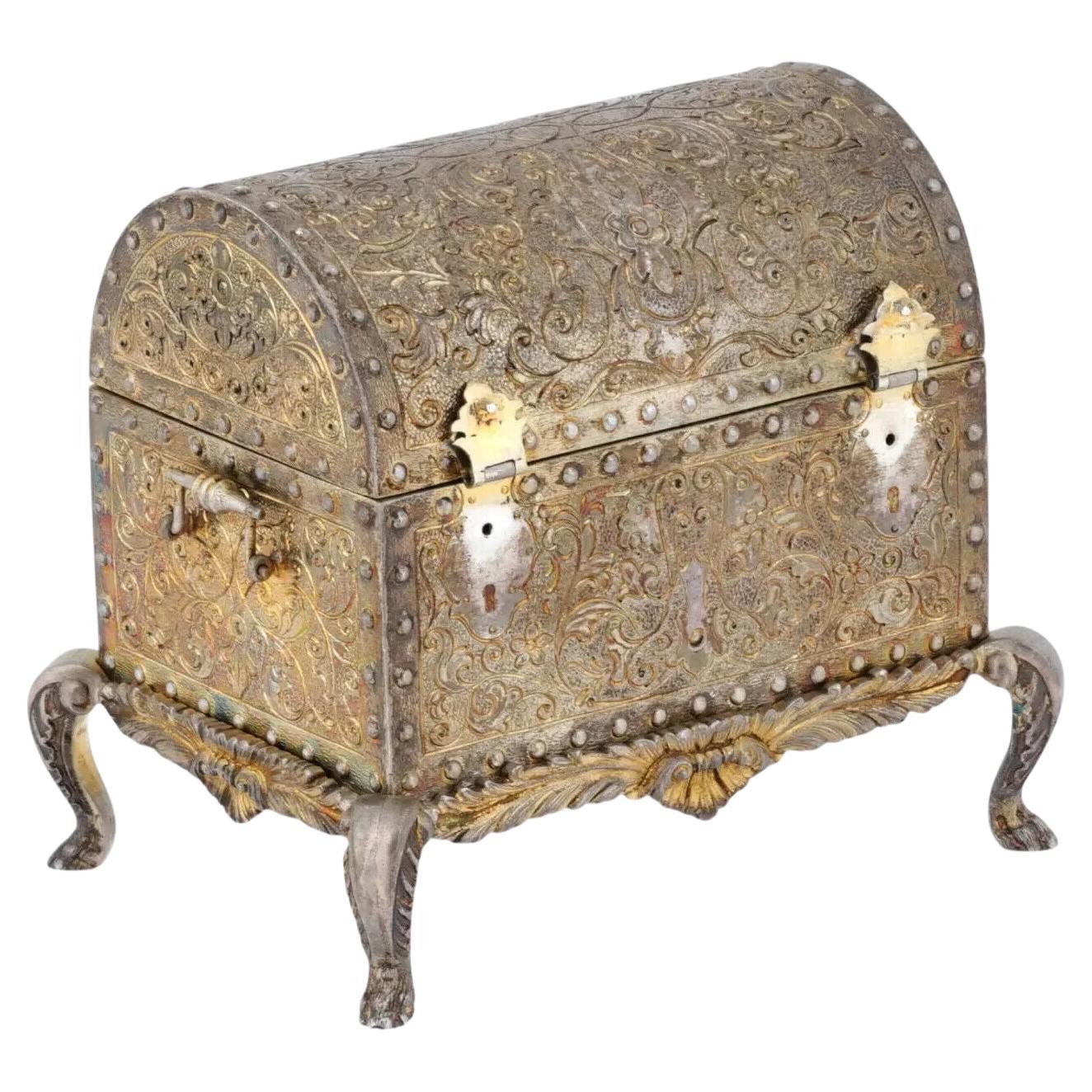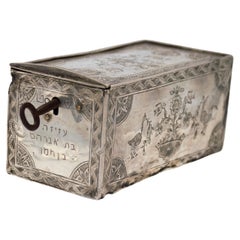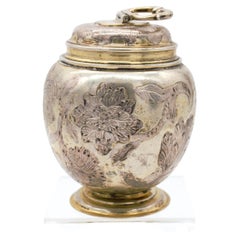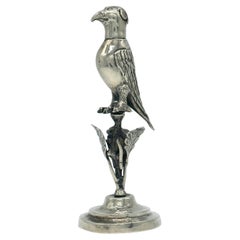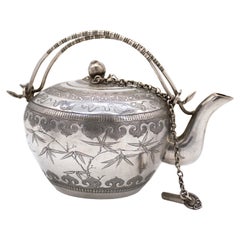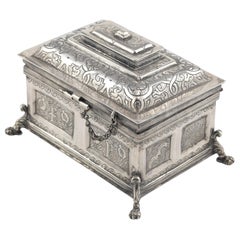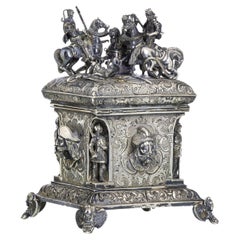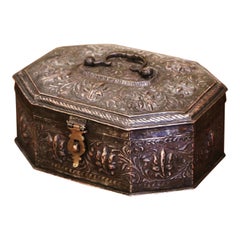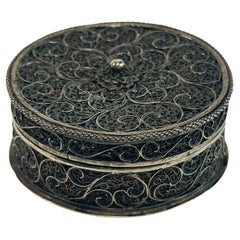Items Similar to Rare silver Herb Box (Yerbera), Upper Peru, Potosí, c. 1775–90 great repoussé
Want more images or videos?
Request additional images or videos from the seller
1 of 19
Rare silver Herb Box (Yerbera), Upper Peru, Potosí, c. 1775–90 great repoussé
$15,000
£11,630.56
€13,197.05
CA$21,501.86
A$23,380.21
CHF 12,319.09
MX$284,001.66
NOK 154,875.78
SEK 145,183.54
DKK 99,032.31
About the Item
Herb Box (Yerbera), Upper Peru, possibly Potosí, c. 1775–90, cast, repoussé, and chased silver,
the design is very intricate, with lions, cats and some other animals, and a women on the lid, it is made in a shell shape with a classical women on top of the lid, the body is all hand made with lions and wild cats with leafs designs, the inner part is divided into two compartments, as usually in this type of boxes. lock is not working but it is very nice and "primitive" looking.
Boxes have a long history across cultures and time. In Spanish America, containers of many types, styles, and materials were cherished as gifts. Known today as yerberas (herb boxes) or coqueras (coca boxes), shell-shaped containers were used to store yerba maté (the mildly stimulating tisane consumed in the viceroyalty of Peru and the Río de la Plata regions), and perhaps also coca leaves (chewed since ancient times to relieve symptoms caused by the high altitude of the Andes) and other substances, which accounts for their interior partitions. Inspired by foreign prototypes, shell-shaped boxes were also produced in silver—the highly coveted metal that was abundantly mined in Potosí, Bolivia. Silver was largely associated with empire building in the early modern world (c. 1500–1800), and used to embellish churches and the homes of the elite to signal the proverbial wealth of viceregal society. Master silversmiths capitalized on the experience of Indigenous artists who had worked with the material for millennia. Its whimsical shape is a local adaptation of rocaille (a typical motif of Rococo ornamentation), which was introduced from Europe and was fashionable across media
- Dimensions:Height: 4.5 in (11.43 cm)Width: 6 in (15.24 cm)Depth: 5.2 in (13.21 cm)
- Materials and Techniques:
- Period:
- Date of Manufacture:1800
- Condition:Wear consistent with age and use. condition of the box is good for its dating, it has some dings, opens in the welds of the base, scratches and overall wear and tear as you can see in the pictures, nice original and untouched condition.
- Seller Location:Tel Aviv - Jaffa, IL
- Reference Number:1stDibs: LU8130242386602
About the Seller
No Reviews Yet
Vetted Professional Seller
Every seller passes strict standards for authenticity and reliability
1stDibs seller since 2023
- ShippingRetrieving quote...Shipping from: Tel Aviv - Jaffa, Israel
- Return Policy
Authenticity Guarantee
In the unlikely event there’s an issue with an item’s authenticity, contact us within 1 year for a full refund. DetailsMoney-Back Guarantee
If your item is not as described, is damaged in transit, or does not arrive, contact us within 7 days for a full refund. Details24-Hour Cancellation
You have a 24-hour grace period in which to reconsider your purchase, with no questions asked.Vetted Professional Sellers
Our world-class sellers must adhere to strict standards for service and quality, maintaining the integrity of our listings.Price-Match Guarantee
If you find that a seller listed the same item for a lower price elsewhere, we’ll match it.Trusted Global Delivery
Our best-in-class carrier network provides specialized shipping options worldwide, including custom delivery.More From This Seller
View Allextremely rare Algerian Judaica silver, jewish Dowry box early 19th century
Located in Tel Aviv - Jaffa, IL
Amazing and scarce JUDAICA object, we have here one of the most touching jewish objects we had for a long time, this small silver dowry box was made in Algeria in the early 19th century, it is all covered with symbols of jewish faith and of couples, the sliding lid has 2 flanking birds with hamsa (protective hand) on each side and a flower vase in the middle.
one side shows two flanking lions with a tree in the middle and the other side shows again two big and two small birds with a flower bowl in the middle, front side has a key hole and next to it there is the Hebrew inscription ס״ט״" which says Siman tov or in English "a good sign" it is taken from the wedding blessing, underneath the lock there is another inscription with the name ״עזיזה בת אברהם בן חמו״ which is the name of the bride, her father and her grandfathers name.
the box is full marked a lot of times with the silversmith mark, every side of the box is marked.
this box was probably ordered by the grooms family to hold the jewelry they are giving to the bride as dowry, this type of objects are rare and there are just a few of them on museum collections.
DOWRY (Heb. נְדֻנְיָה), the property a wife brings to her husband at marriage; the Yiddish equivalent, nadn, is from the same root. The custom of nedunyah became clearly defined and institutionalized only in the talmudic period. In biblical times, mohar (מֹהַר), whereby the groom bought his wife from her father (Gen. 24:53; Ex. 22:15–16; Hos. 3:2), was the accepted practice. It was then customary that the groom give the bride gifts, and that she bring certain property to her husband's home upon marriage: slaves, cattle, real estate, etc. (cf. Gen. 24:59–61; 29; Judg. 1:14ff.; I Kings 9:16). Evidence of the custom of nedunyah is to be found in Tobit (7:14; 8:21) and in the Assuan papyri (Cowley, Aramaic, nos. 15, 18). Gradually, mohar was superseded by the ketubbah custom according to which the husband merely assumed the responsibility of compensation to his wife in case he divorced her: he had to pay her 200 zuzim if she had been a virgin at the time of marriage, and 100 zuzim if a widow or divorcée (see *Ketubbah).
By talmudic times, the institution of nedunyah was prevalent; the father gave a dowry to the bride since the daughter was excluded from paternal inheritance. Fifty zuzim (equivalent to the worth of 180 grams of silver) was the minimum amount a father was obliged to give to his daughter (Ket. 6:5). Parents usually gave much more, according to their social standing. Community funds provided the dowry for an orphan or a very poor girl (ibid.; cf. Sh. Ar., YD 251:8). In case of her father's death, the brothers of a minor girl were obliged to give her the minimum dowry, and the court estimated how much her father would have given her above the minimum dowry. The sum was then taken out of the father's estate and given to the daughter upon majority (Ket. 6:6; 68a–69b). In the absence of such an estimate, each daughter was entitled to receive one-tenth of the value of her father's estate in money, or in valuables (Yad, Ishut, 20:4–7; Sh. Ar., EH 113:4). If the father was unable or unwilling to pay the promised dowry at the betrothal ceremony, the groom could refuse to marry his bride (Ket. 13:5; Ket. 108b–109a). Insistence on exact payment of the promised dowry, however, was frowned upon by later rabbinic authorities (Rema to Sh. Ar., EH 2:1). In certain communities it was customary for the groom's father to make a dowry contribution equal to that of the bride's father (Ket. 102b). The dowry, whether given in real estate, slaves, money, or chattel was recorded in the marriage contract (the ketubbah) and in some instances one-third or one-fifth of the actual value of the dowry was added to the sum mentioned in the ketubbah. Based upon a decree enacted by *Simeon b. Shetah (first century C.E.), the Talmud ruled that the husband and his entire property were liable for compensation as stipulated in the ketubbah, either in case he died (when she collected the sum specified in the ketubbah from the heirs) or in case he divorced his wife (Ket. 82b). For the status of the dowry and the husband's rights and obligations, see below. The rabbinic enactments (Takkanot Shum) by R. Jacob *Tam and by the rabbinic synod of the communities of Speyer, Worms, and Mainz (Germany) stipulated that if a woman died...
Category
Antique Mid-19th Century Algerian Tribal Art
Materials
Silver
Rare German Parcel-Gilt Silver Canister, Abraham Drentwett i, Augsburg 1649-1666
Located in Tel Aviv - Jaffa, IL
Important German parcel-gilt silver canister, Abraham Drentwett I, Augsburg, circa 1649-1666 Abraham Drentwett I is one of Augsburg's foremost silversmiths during the Baroque period. He was Active 1641-1666 , he is best known for having executed Queen Christina's silver throne...
Category
Antique 17th Century German Baroque Sterling Silver
Materials
Silver
RARE Austrian silver (ALT WIEN) Havdalah spice container, Judaica ISRAEL MUSEUM
Located in Tel Aviv - Jaffa, IL
Up for sale is this museum quality Judaica Havdalah spice container, very rare with great provenance!!
This silver spice tower was made in Vienna Austria, on the early part of the 19...
Category
Antique Early 1800s Snuff Boxes and Tobacco Boxes
Materials
Silver
Antique early 20th Chinese Exceptional Solid Silver Teapot, Wu Hua物華, Tianjin
Located in Tel Aviv - Jaffa, IL
Antique early 20th Century exceptionally rare Chinese solid silver teapot, of traditional round form, the body finely engraved in traditional Chinese style, suggesting this teapot was made for the Chinese market. The body engraved with bamboo and butterflies , the unusual handle imitating bamboo, the removable lid set with a peach finial (Peaches are the symbol of longevity). According to Daoist lore, the peaches of immortality grew in the garden of the Queen Mother of the West - Xi Wangmu.
the spout with a hedged cover in the shape of a lingzhi mushroom and a FU symbol of good furtune.
the top frieze is decorated with 8 Chinese symbols: a scroll, a Ruyi scepter, a qin, The Endless Knot, a pendant, an old book, a wrist rest, and two overlapping squares.
The teapot is very unusual, fine and exceptionally crisp. it is made of heavy Gauge silver and the attention to detail and design is simply outstanding.
"WU HUA...
Category
Early 20th Century Chinese Chinese Export Metalwork
Materials
Silver
Amazing Japanese silver teapot and cover, dragon spout Meiji period 19TH century
Located in Tel Aviv - Jaffa, IL
amazing rare archaistic style silver ewer or tea pot with cover, the design is Of archaistic style dragons on the main frieze and on the cover, this style came from ancient Chinese a...
Category
Antique 1890s Japanese Metalwork
Materials
Silver
$12,000
Free Shipping
JUDAICA SILVER ETROG BOX DESIGNED BY LUDWIG WOLPERT. New York, 20th century
Located in Tel Aviv - Jaffa, IL
This charming piece of jewish history in front of you is a one of kind modern Judaica object,
This box used to hold the Etrog To protect the it during the holiday of Sukkot, it is traditionally Wrapped in silky flax fibers and stored in a special decorative box, mostly made from silver.
Wolpert designed this amazing hand hammered Bauhaus style box in 1963-1964 while he was Working in New York. all of the boxes we could found from this design made by Wolpert have The upper part inscribed in a simple engraving with the phrase "Pri Etz Hadar"
In Hebrew ״פרי עץ הדר״. the box in front of you is the only example in existence as far as we Know where the letters are also repoussé and also engraved, such a beautiful and hard to get Combination, the rest of the box is shaped as a modernistic Etrog, all the body of the box is Skillfully hand hammered in a way it reflects the light in a warm and calm way, a true Masterpiece of modern judaica by the great and important artist Ludwig Yehuda Wolpert.
One of the the two great masters of 20th century Judaica.
the Box is marked "WOLPERT" AND "STERLING" and the base has the engraved inscription :
"ALAN WECHSLER GENERAL CHAIRMAN, ALLIED JEWISH APPEAL OF SOUTHERN NEW JERSEY 1978"
Similar boxes can be find in museum collections around the world
In the Jewish Museum New York
In the North Carolina Museum of Art
In The Derfner Judaica Museum
Another similar box was featured in the Israel Museum exhibition
"Forging Ahead, Wolpert and Gumbel, Israeli Silversmiths for the Modern Age"
Ludwig Yehuda Wolpert was born in Hildesheim, Germany, to an Orthodox family. In 1916-1920, He began his studies in sculpture at the Frankfurt School of Art. In 1925-1928, he studied Goldsmithing at the Frankfurt School of Art.
Following the presentation of the works in the 1930 exhibition "Kult und Form" ("Ritual and Form") at the Jewish Museum in Berlin, his works became well known in the German Jewish World. His works were greatly influenced by Modernist design, especially the Bauhaus Movement. Wolpert's works avoid decoration, relying on clean, geometric shapes. In 1933, Following the Nazi rise to power in Germany, he immigrated to the Mandatory Palestine with His family. There he worked for two years in the workshop of Bernhard Friedländer, where he Designed and produced silverware and Jewish ceremonial art.Together with Victor Solomon...
Category
Vintage 1960s Decorative Boxes
Materials
Silver
You May Also Like
Silver Chest, After 17th Century Models, circa 20th Century
Located in Madrid, ES
Arquette inspired by 17th century models. Silver, Spain, 20th century
Rectangular casket made of silver in its color, with four legs in the corners in the form of roll and finished ...
Category
20th Century European Other Decorative Boxes
Materials
Silver, Other
Silver Box Austria-Hungary 18th Century
Located in Madrid, ES
SILVER BOX
Austria-Hungary 18th Century
in silver with profuse decoration inspired by the Crimean War, in which Russia lost to an alliance of the Ottoman Empire, France, United K...
Category
Antique 18th Century Austrian Baroque Decorative Boxes
Materials
Silver
19th Century French Repousse Silvered Metal Spice or Jewelry Box
Located in Dallas, TX
Crafted in southern France circa 1860, and octagonal in shape, the antique box is built of metal with a silvered finish with repousse floral and leaf motifs throughout. The decorative casket...
Category
Antique Mid-19th Century Decorative Boxes
Materials
Metal
Betzalel Hand-Made Silver Filigree Spice Box
Located in New York, NY
This is a meticulously handcrafted silver filigree spice box, created in the Bezalel School of Arts and Crafts tradition, a hallmark of early 20th-century Jewish artistic expression ...
Category
Early 20th Century Israeli Folk Art Religious Items
Materials
Silver
French Medieval Style Silver Jewelry Box, circa 1880
Located in Miami, FL
A remarkable intricately designed, handcrafted silver box, circa 1880s.
We were told that this box is sterling silver and that the makers mark "M" is that of "M. Mayer". Maurice MAYER was a very prestigious silversmith. Research shows that he was an "Orfèvre de l'Empereur", Napoleon Bonaparte, 1860-1870.
The Minerva hallmarks are not visible, may have been rubbed off from use and cleaning. No documentation.
This intricately carved box depicts the romantic poem of Le Roman de la Rose (The Romance of the Rose). Comes with the original lock and key.
Le Roman de la Rose, begun by Guillaume de Lorris circa 1230 and completed, in a different style, circa 1270-1280, by Jean de Meun, builds on the concept of courtly love found in the poetry of the troubadours. The authors create a complex allegory of the romance between the Lover and the Rose. In the quest to pick the Rose (to achieve the conquest of love), the flower and its attendants represent the Lady and her sentiments while being wooed.
In the first part of the poem, written by de Lorris, the Lover recounts his dream, ending with the winning of a kiss from the Lady. In the dream, the Lover discovers a walled garden and gains entrance thanks to a beautiful young woman. He meets Diversion and dancers who represent courtly values such as Beauty and Generosity. A tour of the garden brings him to a beautiful bed of roses by the Fountain of Love...
Category
Antique 19th Century French Jewelry Boxes
Materials
Sterling Silver
$6,175 Sale Price
35% Off
Antique Portuguese Sterling Silver Box With Stand
Located in Long Island City, NY
An antique Portuguese sterling silver box with a stand. Exact silver guarantee mark used in the Lisbon Assay Office from 1887 to 1932 on the bottom. The box is modeled in the form of...
Category
Antique Late 19th Century Portuguese Decorative Boxes
Materials
Sterling Silver
More Ways To Browse
Rare Antique Silver
Antique Partition
Antique Peruvian Furniture
Peru Silver
Chasing And Repousse
Rare Antique Hammers
Silver Bolivia
Antique Primitive Box
Antique Peruvian Silver
Peruvian Bar
18th Century Primitive American Furniture
18th C Snuff Box
Battersea Enamel Box
Mother Of Pearl Snuff Box
Antique Battersea Boxes
Austria Snuff Box
Opium Box
Shell Snuff Box
